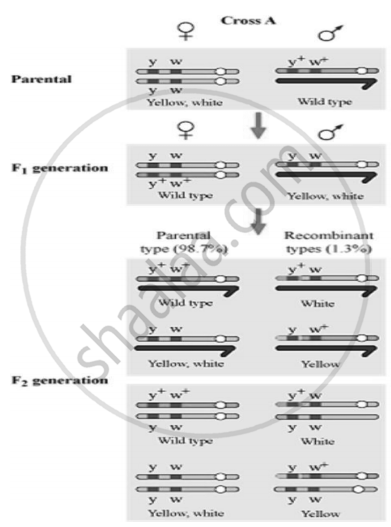Advertisements
Advertisements
प्रश्न
उत्तर
In a dihybrid cross , two pairs of alleles or contrasting characters are considered in parents.
For example, cotyledon colour and seed shape of pea are used as two pairs of alleles.
Suppose, among the two parents, one was true breeding dominant i.e. yellow coloured cotyledons and round seeds, YYRR and the other was a true breeding recessive i.e. green coloured cotyledons and wrinkled seeds, yyrr. On crossing the two parents, F1 generation so obtained had all yellow and round seeds.
On self pollinating, the hybrids - YyRr produced four types of seeds in F2 generation:
(i) Yellow cotyledons and round seeds (YYRR)
(ii) Yellow cotyledons and wrinkled seeds (YYrr)
(iii) Green cotyledons and round seeds (yyRR)
(iv) Green cotyledons and wrinkled seeds (yyrr)
Thus the phenotypic ratio of a dihybrid cross is 9:3:3:1.

APPEARS IN
संबंधित प्रश्न
Two heterozygous parents are crossed. If the two loci are linked what would be the distribution of phenotypic features in F1 generation for a dihybrid cross?
Complete the following sentence with appropriate word:
_______ is the ratio of dihybrid cross.
Which Mendelian idea is depicted by a cross in which the F1 generation resembles both the parents
Select the period for Mendel’s hybridization experiments
What are the reasons for Mendel’s successes in his breeding experiment?
Explain the law of dominance in a monohybrid cross.
Two linked genes a and b show 20% recombination. The individuals of a dihybrid cross between ++ /++ × ab/ab shall show gametes ______.
A dihybrid condition is ______.
Mendel’s last law is ______.
Two genes ‘A’ and ‘B’ are linked. In a dihybrid cross involving these two genes, the F1 heterozygote is crossed with homozygous recessive parental type (aa bb). What would be the ratio of offspring in the next generation?
Given below is a dihybrid cross performed on Drosophila.

Which of the following conclusions can be drawn on the basis of this cross? When yellow bodied (y), white-eyed (w) Drosophila females were hybridized with brown bodied (y+), red-eyed males (w+) and F1 progenies were intercrossed, F2 generation would have shown the following ratio:
From the list given below, select the character which can be acquired but not inherited
Two pea plants - one with round yellow seeds (RRYY) and another with wrinkled green (rryy) seeds produce F1 progeny that have round, yellow (RrYy) seeds.
When F1 plants are self-pollinated, which new combination of characters is expected in F2 progeny? How many seeds with these new combinations of characters will be produced when a total 160 seeds are produced in F2 generation? Explain with reason.
Sahil performed an experiment to study the inheritance pattern of genes. He crossed tall pea plants (TT) with short pea plants (tt) and obtained all tall plants in F1 generation.
What will be set of genes present in the F1 generation?
Sahil performed an experiment to study the inheritance pattern of genes. He crossed tall pea plants (TT) with short pea plants (tt) and obtained all tall plants in F1 generation.
Give a reason why only tall plants are observed in F1 progeny.
Sahil performed an experiment to study the inheritance pattern of genes. He crossed tall pea plants (TT) with short pea plants (tt) and obtained all tall plants in F1 generation.
When F1 plants were cross-pollinated with plants having tt genes, a total of 800 plants were produced. How many of these would be tall, medium height or short plants? Give the genotype of F2 generation.
Mendel's law of independent assortment is based on F2 ratio of:
